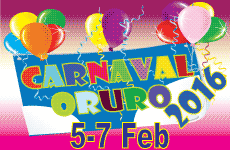
- Home
- Hotels & Hostels
- Tours
- How to Getflights, buses, trains
- Travel Guide
- Travel Servicesmaps, weather, currency
Uyuni Travel Guide.
1. History of Uyuni.

The southwest of Bolivia is perhaps its most magical corner, a wilderness of harsh hillscapes, bubbling geysers and psychedelic mineral colors. Although it gets pilenty of visitors, in many ways it is still a remote wilderness, with rough dirt roads, scattered mining settlements, quinoa-producing villages and little public transportation.
The main town, Uyuni, is a military outpost with a real frontier feel; at times you expect the harsh temperatures and biting winds to do away with it altogether. It is the launching point for expeditions into the region, from the desolate expanses of the salares to the craggy hills of Los Lípez, which rise into the high Andean peaks along the Chilean frontier. Many of these are active volcanoes, and they preside over a surreal landscape of geothermal features and flamingo-filled lakes.
Seemingly built in defiance of the desertlike landscape, Uyuni stands desolate yet undaunted in southwestern corner of Bolivia. Mention Uyuni to a Bolivian and they will whistle and emphasize harto frío? extreme cold. Travelers arrive and eagerly plan a trip around the Southwest Circuit; those who return from the wilderness see Uyuni with new eyes, as a sort of paradise filled with much-missed daily comforts.
Although there is not much to see here, and the wind chill can strip your soul bare as you pace the wide streets, the isolated position of Uyuni and outlook elicit an affectionate respect from both Bolivians and foreign travelers.
Founded in 1889 by Bolivian president Aniceto Arce, Uyuni today remains an important military base; tourism and mining are the other major sources of employment in the town.
2. Basic Information About Uyuni.
Emergency There is quite a bit of petty theft around the bus and train stations. Police station (corner Ferroviaria and Bolívar) If you happen to get mugged, head here to fill out a report.
Immigration ((Ferroviaria between Arce and Sucre; 8:30-12:00 and 14:30-18:00 Mon-Fri, 8:30-12:00 Sat and Sun).
Internet Access There are several internet places in town but most have painfully slow dial-up connections.
Laundry Most hotels offer some sort of laundry service. Lavarap (cnr Ferroviaria and Sucre; 7:00-22:00).
Medical Services Hospital (T. 6932025) Along Arce on the edge of town, does good work and accepts most travel insurance.
Money The lone and long-awaited ATM outside the Banco de Crédito (Potosí, between Arce and Bolívar) is very often out of service, especially on weekends, so bring sufficient amounts of cash. The same bank gives cash advances on credit cards at the best rate, and changes US dollars.
Post and Telephone The main post office is on the clock. The modern Entel office is in fronto to tower clock.
Tourist Information Dirección de Turismo (Potosí corner Arce, 8:30-12:00 and 14:00-18:00 Mon-Fri) Inside the clock tower, this tourism office has sporadic hours and, theoretically, distributes information about Uyuni and the rest of Bolivia. Printed materials were being prepared at the time of research. Office of Reserva Nacional de Fauna Andina Eduardo Avaroa (REA; T/fax 6932400, Colón, at Avaroa; 8:30-12:00 and 14:30-18:30 Mon-Fri) Somewhat helpful administrative office for the park of the same name. You can buy your park entry here if going under your own steam.
Electricity 220V.
3. Weather in Uyuni.
Climatically, the best months to visit are August, September and October, after the worst of the winter chills and before the summer rains. From May to early July, nighttime temperatures combined with stiff winds can lower the wind-chill temperature to -40.5°C. Summer is warmer but, for an arid area, there is quite a lot of rainfall between November and March. At any time of year you will need protection against sun, wind and cold.


4. The City of Uyuni.
a) The Museo Arqueología y Antropológico de los Andes Meridionales
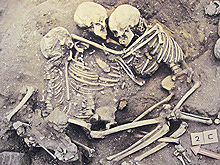
The Museo Arqueología y Antropológico de los Andes Meridionales (Arce at Colón, 8:30-12:00 and 14:00-18:30 Mon-Fri) is a small affair featuring mummies, long skulls, fossils, ceramics and textiles. There are Spanish descriptions of the practices of mummification and cranial deformation.
b) Cementerio de Trenes
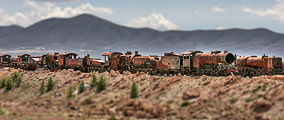
The only other real tourist attraction of Uyuni is the Cementerio de Trenes (Train Cemetery), a large collection of historic steam locomotives and rail cars, which are decaying in the yards about 3km southwest of the station along Av Ferroviaria. There have long been plans to turn the collection into a railway museum, but that seems a pipe dream and they will most likely just keep on rusting. Many tours visit the train cemetery as a first or last stop on the three-day salar circuit.
c) Market
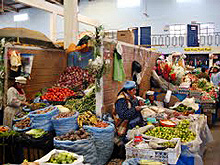
The big market day in Uyuni is Thursday when Potosí gets taken over by stalls selling anything from arts and crafts to television sets; Sunday is a smaller market day.
5. Around Uyuni.
a) The Soutwestern Circuit
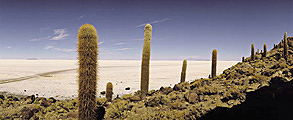
While you can theoretically visit the Salar de Uyuni and the attractions of the Southwest Circuit independently, it is extremely challenging due to unreliable transport and the remoteness of the area. So the vast majority of people take an organized tour from either Uyuni or Tupiza.
The most popular tour is the three day circuit taking in the Salar de Uyuni, Laguna Colorada, Sol de Mañana, Laguna Verde and points in between. Check with the agency about reversing the standard circuit, that way, you will arrive at the salar early in the morning on the third day, when the lighting is at its best. The main advantages are that the circuit takes in many stunning natural sights and that, because it is so popular, you will have little trouble finding companions to make up the numbers on a tour. The disadvantage is that it is very much a trail ? it is not unusual to see a couple of dozen 4WDs parked up alongside some of the major attractions.
If you have the time and cash, opt for the four-day circuit which is a lot more rewarding and many end up in Tupiza.
Possible activities include climbing volcanoes and visiting some off-the-beaten path attractions.
Another option offered by a variety of agencies is to do the three-day circuit and then connect at Laguna Verde with an onward transfer to the pretty town of San Pedro de Atacama in northeast Chile. This is now a popular means of crossing between Bolivia and Chile. When booking, check that the price of the transfer to San Pedro is included.
Shorter visits, basically taking in just the salar (Two days and one night). Single-day trips also run, but these have angered the locals around the salar, who feel that their community gains nothing from these visits.
Note that during the rainy season, between January and March, some agencies shut down. Those that do operate offer cheaper tours and tend to be more open to negotiation.
Ensure the vehicle and driver are reliable, as entering the salar during the rains can be downright dangerous.
With the increasing number of people on the standard trail, and a growing number of interesting choices of accommodations around the Salar de Uyuni and Southwest Circuit, it is an appealing prospect to customize your own tour, striking off into lesser-known areas, or incorporating some climbing or walking opportunities.
Some agencies are more willing to do this than others; be especially wary when they have got a standard tour to fill and will promise you any route you want just to sign you up!.
Accommodations tend to be in basic hostels that are icy at night. If you do not have a warm sleeping bag, make absolutely certain that the agency provides one; no one should make these trips without one.
If you are willing to pay a little extra, there are now several more enticing lodging choices around the salar.
Food varies in quality and quantity. There have been reports of vegetarian requests of travelers not being heard so make sure you get that in writing. It is always better to sign up with an agency that has a cook onboard, otherwise the driver will double as the cook, which is not an appealing prospect.
b) Pulacayo
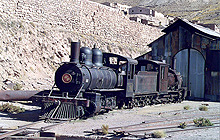
At the semi-ghost town of Pulacayo, 22km northeast of Uyuni, brilliantly colored rocks rise beside the road and a mineralrich stream reveals streaks of blue, yellow, red and green. The Pulacayo mines north of the village, which yielded mainly silver, were first opened in the late 17th century; today, only a few hundred hardy souls remain. There are several kilometers of mine tunnels to explore, if you find a local guide. Also worthwhile is the mill that spins llama wool into cloth, and the mansion of the 22nd president of Bolivia, Aniceto Arce Ruíz. Pulacayo is also home to several decaying steam locomotives that were originally imported to transport ore.
c) Colchani
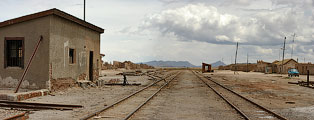
Right on the edge of the Salar de Uyuni, Colchani, 20km north of Uyuni, is the easiest point to access that great salt flat, and the place to go if you just want a glimpse of it without going on a tour. There remain at least 10 billion tons of salt in the Salar de Uyuni, and around Colchani campesinos (subsistence farmers) hack it out with picks and shovels and pile it into small conical mounds that characterize the salar landscape. Most of the salt is sold to refiners and hauled off by rail, but some is exchanged with local villages for wool, meat and grease. Most tour groups stop at the small museum dealing with the salar and the salt trade. Apart from the handful of salt sculptures, it is more of a souvenir stop selling ponchos, hats, gloves and sweaters. Another attraction on the salar tourist circuit is just southwest of Colchani, the extraordinary Cooperativa Rosario workshop, also called the Bloques de Sal (Salt Blocks). Here, blocks of salt are cut from the salar and made into furniture and lively works of art. Colchani is also home to several salt hotels.
6. Tours and Activities in Uyuni
a) The Southwest Circuit Tour
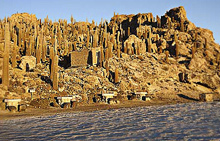
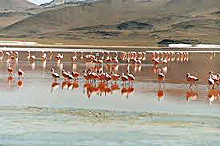
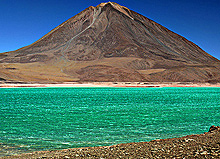
The southwestern corner of Bolivia is an aweinspiring collection of harsh, diverse landscapes ranging from the blinding white Salar de Uyuni salt flat to the geothermal hotbed of Los Lípez, one of the harshest wilderness regions of the wolrd and an important refuge for many Andean wildlife species. The ground here literally boils with minerals, and the spectrum of colors is extraordinary.
A circuit from Uyuni takes you through absolutely unforgettable, literally breathtaking landscapes and is the highlight of many visitors to Bolivia.
Much of the region is nominally protected in the Reserva Nacional de Fauna Andina Eduardo Avaroa (REA), which was created in 1973, covers an area of 7150 sq km and receives in excess of 50,000 visitors annually. Its emphasis is on preserving the vicuña and the yareta plant, both of which are threatened in Bolivia, as well as other unique ecosystems and endemic species.
Most people visit the region on an organized trip from Uyuni or Tupiza.
1.- Salar de Uyuni One of the most evocative and eerie sights of the globe, the largest salt flat of the world (12,106 sq km) sits at 3653m. When the surface is dry, the salar is a pure white expanse of the greatest nothing imaginable ? just the blue sky, the white ground and you. When there is a little water, the surface perfectly reflects the clouds and the blue Altiplano sky, and the horizon disappears. If you are driving across the surface at such times, the effect is positively surreal, and it is hard to believe that you are not actually flying through the clouds.
The Salar de Uyuni is now a center of salt extraction and processing, particularly around the settlement of Colchani. The estimated annual output of the Colchani operation is nearly 20,000 tons, 18,000 tons of which is for human consumption while the rest is for livestock.
2.- Isla Incahuasi For most Salar de Uyuni tours, the main destination is the spectacular Isla Incahuasi, better known as Isla del Pescado, in the heart of the salar 80km west of Colchani. This hilly outpost is covered in Trichoreus cactus and surrounded by a flat white sea of hexagonal salt tiles. It was once a remarkably lonely, otherworldly place but since the advent of salar tours, it has become overrun with tourists. All the tour groups arrive at the same time, at midday, and swarm over the hiking trails chasing the perfect photo of cacti and salt.
This is where most groups have their lunch but there is also a café-restaurant. Altogether an industrialized tourist experience, it is still a beautiful sight if you forget the crowds.
3.- Tunupa and Coquesa A rounded promontory juts into the Salar de Uyuni diagonally opposite Colchani, and on it rises Volcán Tunupa (5432m). One legend states that Atahualpa slashed the breast of a woman called Tunupa on its slopes, and the milk that spilled out formed the salar. Another story goes that, back in those ancient days, mountains were men and women. Right after giving birth to their baby, Tunupa learned her man was living with another woman. Devastated, she wept and wept, spilling her salty tears over her breast milk, and creating this vast area of sadness and beauty that is now the salar.
Altitude aside, this hulking yellow mountain is a relatively easy climb. At the foot of the volcano is the village of Coquesa in an area specked with ruined ancient villages and burial grounds. Articles of clothing and artifacts in ceramic, gold and copper have been discovered at some of the sites, indicating the presence of an advanced but little-known culture. Unfortunately, its remoteness has left it vulnerable to amateur treasure hunters who have plundered several items of archaeological value. At Hospedaje Chatahuana, you can ask for the keys to the Museo Coquesa, which has a collection of ceramics and mummies.
In Coquesa, you can also arrange a nighttime visit to the nearby observatory, to really appreciate the starry skies.
4.- Los Lipez Entering the remote and beautiful region of Los Lípez, many tours pass through a military checkpoint at the village of Colcha K (col-cha kah), where there is a pleasant adobe church and a series of fairly rudimentary dormitory accommodations. About 15km further along is the quinoa-growing village of San Juan at an elevation of 3660m. It has a lovely adobe church, a population of 1000, and several volcanic-rock tombs and burial chullpas in the vicinity. The communityrun Museo Kausay Wasi displays regional archaeological finds.
At this point the route turns west and starts across the borax-producing Salar de Chiguana, where the landscape opens up and snowcapped Ollagüe (5865m), an active volcano straddling the Chilean border, appears in the distance.
The route then turns south and climbs into high and increasingly wild terrain, past the several mineral-rich lakes filled with flamingos and backed by hills resembling spilled chocolate sundaes. After approximately 170km of rough bumping through marvelous landscapes, the road winds down to the muchphotographed Árbol de Piedra (Stone Tree) in the Desierto Siloli, 18km north of Laguna Colorada.
The next attraction, Laguna Colorada is a fiery red lake (4278m) that covers approximately 60 sq km and reaches a depth of just 80cm. The rich red coloration is derived from algae and plankton that thrive in the mineral-rich water, and the shoreline is fringed with brilliant white deposits of sodium, magnesium, borax and gypsum.
The lake sediments are also rich in diatoms, tiny microfossils used in the production of fertilizer, paint, toothpaste and plastics, and as a filtering agent for oil, pharmaceuticals, aviation fuel, beer and wine. More apparent are the flamingos that breed here; all three South American species are present. The clear air is bitterly cold and winter nighttime temperatures can drop below -20°C.
Apart from tour groups, most vehicles along the tracks around Laguna Colorada will be supplying or servicing mining and military camps or the geothermal project 50km south at Sol de Mañana. The main interest here is the 4850m-high geyser basin with bubbling mud pots, hellish fumaroles and the thick and nauseating aroma of sulfur fumes. Approach the site cautiously; any damp or cracked earth is potentially dangerous and cave-ins do occur, sometimes causing serious burns.
At the foot of Cerro Polques lies the Termas de Polques, a small 29.4°C hot-spring pool, and an absolute paradise after the chilly salar nights. Although they are not boiling by any means, they are suitable for bathing, and the mineral-rich waters are thought to relieve the symptoms of arthritis and rheumatism. There is a restaurant here, and changing sheds with toilet facilities.
The stunning blue-green Laguna Verde (4400m) is tucked into the southwestern corner of Bolivian territory, 52km south of Sol de Mañana. The incredible green color comes from high concentrations of lead, sulfur, arsenic and calcium carbonates. In this exposed position, an icy wind blows almost incessantly, whipping the water into a brilliant green-and-white froth. This surface agitation, combined with the high mineral content, means that it can remain liquid at temperatures as low as -21.2°C.
Behind the lake rises the cone of Volcán Licancabur (5960m), whose summit is said to have once sheltered an ancient Inca crypt. Some tours include an ascent of Licancabur, and although it presents no technical difficulties, the wind, temperature, altitude and ball-bearing volcanic pumice underfoot make it quite grueling.
Where the route splits about 20km south of Sol de Mañana, the more scenic left fork climbs up and over a 5000m pass, then up a stark hillside resembling a freshly raked Zen garden dotted with the enormous Rocas de Dalí, which appear to have been meticulously placed by the surrealist master Salvador himself.
5.- Isla Cáscara de Huevo This region is a land of bizarre lava formations, active volcanoes, abandoned villages, badlands, salt flats, pre-Incan cave cemeteries, lone quinoa fields, flying condors, multicolored lagoons and sulfur lakes. We have listed some of the places where you will not be surrounded by packs of jeeps and other travelers, where the feel of the last frontier is true and real.
The small Eggshell Island was named for the broken shells of eggs of the birds that litter it. It lies near the southern end of the Salar de Uyuni and is visited mainly to see the strange patterns of salt crystallization in the area, some of which resemble roses.
6.- Gruta de las Galaxias Some agencies now offer a side trip to Aquaquiza, a quinoa-producing village in Nor Lípez. The attraction of the area lies 8km away, Gruta de las Galaxias and Cueva del Diablo.
Discovered in 2003, Gruta de las Galaxias is a small two-level grotto full of beautiful petrified algae and corrals from the ancient lake. Part of the same complex is Cueva del Diablo, a cave sacred to the locals with a pre-Incan cemetery scattered with small chullpas. Note the cross as you enter the cave, marking where a shepherd girl was found mysteriously dead after seeking protection from a storm inside the cave. There is a viewpoint at the top to admire the spectacularly desolate scenery and the petrified cacti.
7.- Salar de Coipasa This great 2218-sq-km remote salt desert, northwest of the Salar de Uyuni at an elevation of 3786m, was part of the same system of prehistoric lakes as the Salar de Uyuni ? a system that covered the area over 10,000 years ago. The 4WD-only road to the Salar de Coipasa is extremely poor and the salt is thin so it is easy to get stuck, especially during the rainy season. If you go, make sure the vehicle and the driver are reliable.
The salt-mining village of Coipasa, which (not surprisingly) is constructed mainly of salt, occupies an island in the middle of the salar. You can also reach the Salar de Coipasa from Oruro province.
8.- Lagoons The blue lake of Laguna Celeste or, more romantically, heaven lake, is still very much a peripheral trip for most Uyuni agencies, but it is gaining popularity with adventurous travelers as a one-day detour.
A local legend suggests the presence of a submerged ruin, possibly a chullpa, in the lake. Behind the lake, a road winds its way up Volcán Uturuncu (6020m) to the Uturuncu sulfur mine, in a 5900m pass between the mountain?s twin cones. That means it is more than 200m higher than the road over the Khardung La in Ladakh, India, making it quite possibly the highest motorable pass in the world.
In the vast eastern reaches of Sud Lípez are numerous other fascinating mineral- rich lakes that are informally named for their odd coloration and have so far escaped much attention. Various milky-looking lakes are known as Laguna Blanca, sulfurcolored lakes are Laguna Amarilla and winecolored ones are known as Laguna Guinda.
Laguna Cañapa and Laguna Hedionda are also part of some circuits. You can negotiate to add any of these to a tailored circuit.
9.- Quetena Chico and AroundAbout 120km northeast of Laguna Verde and 30km southwest of Laguna Celeste is the small mining settlement of Quetena Chico, which has a few basic services and supplies, a military post and the Centro de Ecología Chaska, which has an exhibition on the geology and biology of the Los Lípez region, and the lives of the local llama herders.
Southeast of here, 6km away, is the picturesque abandoned village of Barrancas, which nestles against a craggy cliff.
Heading back toward Uyuni, the village of Villa Mar has an interesting mercado artesanal (craft market) that is worth a visit. Stretch your legs by strolling the 4km to some of the most spectacular pinturas rupestres of the area (rock paintings), with impressive human figures wearing headdresses, and incised animals.
10.- Valles de Rocas and San Cristóbal In the midst of high, lonesome country stretch several valleys of bizarre eroded rock formations known as Valles de Rocas. These strangely shaped badlands are great for a wander and snapping some great photos. From the dusty village of Alota nearby, it is a six-hour jostle back to Uyuni through a string of authentic villages, the most picturesque of which, Culpina K, has colorful little houses and a cafe.
The mining village of San Cristóbal is worth a stop for the lovely 350-year-old church. The entire village, including the church and the cemetery, was moved from its original location next to the mine by the American-Japanese mining project that took over the area digging for lead, zinc and silver.
7. Festivals and Events.
January 1: New Year 's Day.
February or March (changeable date): Carnival.
April (Changeable date): Easter.
Palm Sunday: The Saturday before Easter. People enter temples with branches which the clergy bless.
Holy Thursday: It is a tradition of the people to visit 12 temples of the city, one for each apostle, in this day.
Good Friday: Procession of the Holy Sepulchre.
June (Changeable date):
Corpus Christie: Commemoration of the Body of Christ.
July 11: Anniversary of Uyuni.
The big annual festival of Uyuni falls on July 11 and marks the founding of the town. Celebrations entail parades, speeches, dancing, music and, naturally, lots of drinking.
July 16: Feast of Carmen.
September 21: Day of Spring. Youth and Students of Bolivia.
First Sunday in October: Feast of the Virgin of Merced.
Second Sunday in October: Feast of the Virgin of Rosario.
November 1: Todos Santos (All Saints Day).
This is a pre-columbian tradition when the people go to visit the Tombs prepared at home by the relatives of the deceased and where the friends are offered the same food and drink liked by him.
November 2: Difuntos (Day of the Deceased)
The tombs are dismantled and the people celebrate in the memory of the deceased.
November 3: Alma Cacharpaya (Soul of the Calypsobreakers)
Those in charge of dismantling the tombs show up in the home of the deceased with an orchestra so that the soul of the deceased will be happy.
December 24 and 25: Christmas Eve and Christmas day.
8. Travel Companies and Tour Operators in Uyuni.
Andes Salt Expeditions A confident tour company, offering tours from one, two, three and four days, transfers to San Pedro Atacama in Chile, bookings in advance are highly recommended. Website
Andrea Tours Plus another office at Peru 200, behind the bus terminal.
Blue Line Service (Ferroviaria # 3).
Cordillera (Ferroviaria # 314).
Estrella del Sur (Arce, at bus terminal).
Expediciones Empexsa (Ferroviaria s/n).
Fremen Tours (Sucre # 325) More upmarket.
Natour (Santa Cruz between Colón and Potosí) Upscale operator.
Reli Tours (Arce # 42)
Toñito Tours (Ferroviaria # 152) More upmarket.
Turismo El Desierto (Arce # 42)
10. Restaurants and Bars in Uyuni.
Restaurant 16 de Julio (Arce # 35) Right along the main strip, this is a good place to escape the fellow gringos. Pleasant and friendly, it has a full spectrum of international and Bolivian dishes. Expect to wait a while to get served, especially at lunchtime when locals flock here.
La Loco (Potosí, between Sucre and Camacho, 16:00-2:00, closed in low season) This friendly French-run restaurant and pub is a barn-like space that is lit low and furnished with comfortingly chunky wooden furniture around a log fire. There are plenty of drinks and a short but classy menu that offers croques monsieur (grilled ham and cheese sandwiches), crepes and llama steaks with a gourmet touch.
Minuteman Revolutionary Pizza (T. 6932094, Ferroviaria # 60, breakfast and dinner) This convivial spot, inside the Toñito Hotel, run by Chris from Boston and his Bolivian wife Sussy, is a deserved favorite for travelers with the best pizzas in town, tasty alternatives like salads, pastas and sandwiches and fantastic desserts. It is also a cozy spot for a beer or candlelit glass of Tarija wine or a hearty breakfast with all you can drink coffee or tea. If you have old sunglasses, you can do a good deed ? drop them off here and they will be donated to the salt workers in Colchani.
Extreme Fun Pub (T. 6932102, Potosí # 9) This relaxed spot is a very enticing place for a tea or coffee, a meal or sociable cocktail ? try a Sexy Llama Bitch. It has salt floors, friendly service, a book exchange and beautiful salar photos. It is also a good place to learn the classic Bolivian dice games or engage in an extreme challenge drink competition: who will chug down 10 drinks in the shortest time possible.
11. Getting There and Away.
Air Amaszonas offers flights two days a week from/to La Paz.
Bus There is a new bus terminal in the works but it will most likely be a couple of years before it opens. For now, all buses are still leaving from the west end of Av Arce, walk a couple of minutes from the plaza. There is a choice of companies to most destinations, so ask around to get the best price or service
- La Paz-Uyuni-La Paz: (552 Km paved and unpaved road) Daily departures at 22:00, 10 hours trip (60 to 80 BOB). Trans Omar and Todo Turismo are good options.
- Sucre-Uyuni-Sucre: (381 Km paved road) Daily departures at 8:30, 9 hours trip (52-80 BOB). 6 de Octubre is the only one company with direct buses from Sucre-Uyuni-Sucre.
- Potosi-Uyuni-Potosi: (219 Km paved road) Daily departures at 11:00 and 18:00, 6 hours trip (35-45 BOB).
- Oruro-Uyuni-Oruro: (323 Km paved and unpaved road) Daily departures at 6:00, 8 hours trip (60 BOB), this bus continues to Villazon (border with argentinean side) and conecctions with Salta-Buenos Aires.
- Tupiza-Uyuni-Tupiza: (480 Km unpaved road) Daily departures at 22:00, 15 hours trip (110 BOB).
- Calama-Uyuni-Calama: (500 Km paved and unpaved road) There are buses at 3:30am on Monday and Thursday and at 5am on Sunday and Wednesday to Calama (nine hours and 100 BOB) in Chile. You will have to change buses in Avaroa at the Chilean border; there are sometimes waits of up to two hours.
Train Uyuni has a modern, well-organized train station (T. 6932320). Seats often sell out so buy your ticket several days in advance or get an agency to do it for you.
Comfortable Expreso del Sur trains ramble to Oruro (salón/ejecutivo, seven hours) on Wednesday and Saturday at 12:05am (arriving the next morning, on Thursday or Sunday) and southeast to Tupiza (5.5 hours) and Villazón (8.5 hours) on Tuesday and Friday at 10:40pm.
Wara Wara del Sur trains chug out of the station at 1:45am on Monday and Thursday nights for Oruro (popular/salón/ejecutivo, 7.5 hours) and on Sunday and Wednesday nights at 2:50am for Tupiza (six hours) and Villazón (10 hours). Note that during the rainy season the trains coming from Villazón tend to run late.
Depending on size, you may have to check your backpack/case into the luggage compartment. Look out for snatch thieves on the train just before it pulls out.
On Monday at 3:30am a train trundles west for Avaroa (five hours) on the Chilean border, where you cross to Ollagüe and may have to wait a few hours to clear Chilean customs. From here, another train continues to Calama (six hours from Ollagüe). The whole trip can take up to 24 hours but it is a spectacular, if uncomfortable journey. Taking a bus to Calama is more reliable.
Latest News

Bolivia Independence Day
2014-08-10
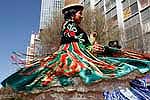
Urkupiña Festival in Cochabamba
2014-08-10

Anniversary of La Paz Department on July 16th
2014-07-13
- Best Hostel Accommodation
- Cheapest Internet Prices
- Bolivia Based WebSite
 Español
Español Deutsch
Deutsch Français
Français
